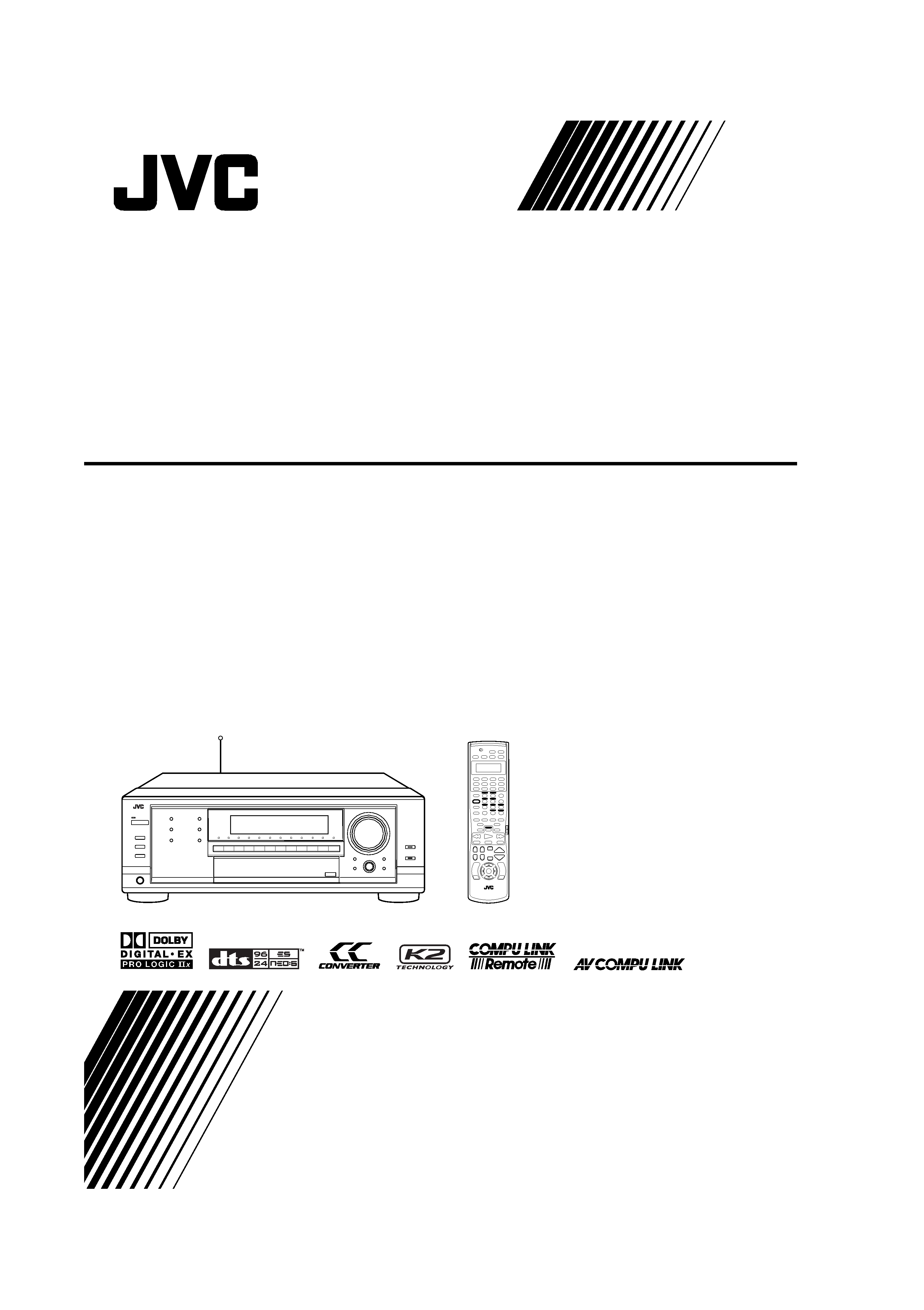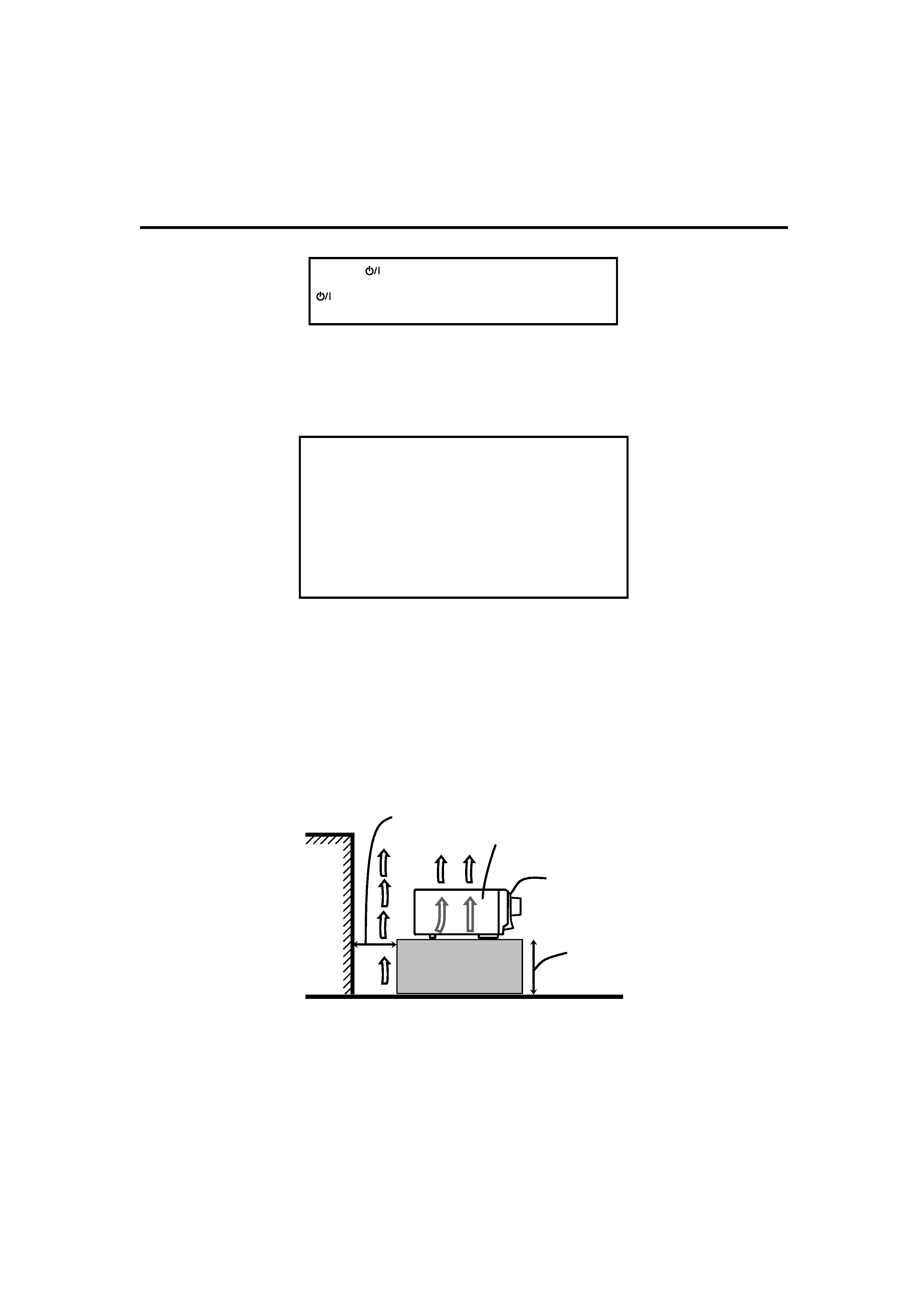
LVT1198-003A
[UJ]
RX-8040B
AUDIO/VIDEO CONTROL RECEIVER
INSTRUCTIONS
Cover_8040[UJ].p65
04.5.14, 11:34
1

G-1
CAUTION
To reduce the risk of electrical shocks, fire, etc.:
1.
Do not remove screws, covers or cabinet.
2.
Do not expose this appliance to rain or moisture.
Warnings, Cautions and Others
Caution
STANDBY/ON button!
Disconnect the mains plug to shut the power off completely. The
STANDBY/ON button in any position does not disconnect
the mains line. The power can be remote controlled.
CAUTION
·
Do not block the ventilation openings or holes.(If the ventilation
openings or holes are blocked by a newspaper or cloth, etc., the
heat may not be able to get out.)
·
Do not place any naked flame sources, such as lighted candles,
on the apparatus.
·
When discarding batteries, environmental problems must be
considered and local rules or laws governing the disposal of
these batteries must be followed strictly.
·
Do not expose this apparatus to rain, moisture, dripping or
splashing and that no objects filled with liquids, such as vases,
shall be placed on the apparatus.
Caution: Proper Ventilation
To avoid risk of electric shock and fire and to protect from damage.
Locate the apparatus as follows:
Front:
No obstructions open spacing.
Sides:
No obstructions in 10 cm from the sides.
Top:
No obstructions in 10 cm from the top.
Back:
No obstructions in 15 cm from the back.
Bottom: No obstructions, place on the level surface.
In addition, maintain the best possible air circulation as illustrated.
Wall or
obstructions
Spacing 15 cm or more
Front
Stand height 15
cm or more
Floor
RX-8040B
Safety_8040[UJ].p65
04.5.14, 11:34
1

1
Introduction
We would like to thank you for purchasing one of our JVC products.
Before operating this unit, read this manual carefully and thoroughly to obtain the best possible performance
from your unit, and retain this manual for future reference.
Features
CC (Compression Compensative) Converter
CC Converter eliminates jitter and ripples, achieving a drastic
reduction in digital distortion by processing the digital music data
in 24 bit-quantization and by expanding the sampling frequency to
128 kHz (for fs 32 kHz signals)/176.4 kHz (for fs 44.1 kHz
signals)/192 kHz (for fs 48 kHz signals). By using the CC
Converter, you can obtain a natural sound field from any source.
(See page 23 for details.)
K2 Technology
K2 Technology has been designed to enable natural audio
reproduction, achieving a drastic reduction in digital distortion
and creating original sound ambience with high precision.
Compatible with various audio formats including
Dolby Pro Logic IIx
This receiver allows you to enjoy audio formats such as Dolby
Digital EX, Dolby Pro Logic IIx, DTS-ES, DTS Neo:6, and DTS
96/24.
· This receiver is also compatible with Dual Mono signals
recorded in Dolby Digital and DTS discs.
DAP (Digital Acoustic Processor)
Sound field simulation technology allows precise ambience
recreation of existing theaters and halls. Thanks to the high-
performance DSP (Digital Signal Processor) and high-capacity
memory, you can enjoy multi-channel surround sound by playing
2-channel or multi-channel software according to the speaker
setting.
Multi-channel headphone virtual surround
sound--3D Headphone mode
The built-in headphone virtual surround system is compatible with
multi-channel software like Dolby Digital, DTS, etc. Thanks to
the signal processing algorithms used by the high-performance
DSP, you can enjoy a natural surround sound through the
headphones.
Multi-room operations
You can connect two pairs of front speakers to this receiver, and
use them to listen to different sources in different rooms (Zone 1
and Zone 2) at the same time.
COMPU LINK/AV COMPU LINK remote control
systems
These functions allow you to operate other JVC's audio/video
components from this receiver.
Precautions
General
· Be sure your hands are dry.
· Turn the power off to all components.
· Read the manuals supplied with the components you are going to
connect.
Power sources
· When unplugging the receiver from the wall outlet, always pull
the plug, not the AC power cord.
· Do not handle the AC power cord with wet hands.
· If you are not going to operate the receiver for an extended period
of time, unplug the AC power cord from the wall outlet.
Multi-room operations
· Do not use the remote control outdoors or install the speakers
outdoors.
· When operating the receiver from a place where you cannot see
the receiver (for example, when controlling the receiver installed
in the living room from the kitchen), pay attention to the following
not to surprise other people:
Be careful not to turn up the volume too high when controlling
the receiver without listening to the playback sound.
Be careful not to surprise other people with a sudden sound
coming out of the receiver when turning it on. (A sudden stop of
the sound may also surprise other people.)
· If the receiver operates by itself or malfunctions, the following
causes should be considered:
Interference to RF communication between the receiver and the
remote control from outside.
The remote control is operated unintentionally. For example, a
book is placed on the remote control, possibly, depressing some
of its buttons.
· If your neighbour uses the same or similar RF remote control
system, the receiver may happen to receive the RF signals sent
from such an RF remote control system, which could cause your
receiver to be operated unintentionally. If this happens, stop using
the RF rod antenna and the remote control, and consult your JVC
dealer or the nearest JVC Service Center.
Location
· Install the receiver in a location that is level and protected from
moisture and dust.
· The temperature around the receiver must be between 5°C and
35°C.
Ventilation
High power amplifiers built in this receiver will generate heat inside
the cabinet. For safety, observe the following carefully.
· Make sure there is good ventilation around the receiver. Poor
ventilation could overheat and damage the receiver.
· Do not block the ventilation openings or holes. (If the ventilation
openings or holes are blocked by a newspaper or cloth, etc., the
heat may not be able to get out.)
Others
· Do not insert any metal object into the receiver.
· Should any metallic object or liquid fall onto the unit, unplug the
unit and consult your dealer before operating any further.
· Do not expose this apparatus to rain, moisture, dripping or
splashing and that no objects filled with liquids, such as vases
shall be placed on the apparatus.
· Do not disassemble the receiver or remove screws, covers, or
cabinet.
If anything goes wrong, unplug the AC power cord and consult your
JVC dealer.
1-15_8040[UJ].p65
04.5.14, 11:34
1

2
Table of Contents
Parts Identification ...................................... 3
Getting Started ........................................... 7
Checking the Supplied Accessories ........................................... 7
Adjusting the Voltage Selector ................................................... 7
Connecting the FM and AM Antennas ....................................... 7
Connecting the Speakers and Subwoofer ................................... 8
Connecting Audio/Video Components ..................................... 10
7 Analog connections .......................................................... 10
7 Digital connections ........................................................... 14
Connecting the RF Rod Antenna and IR Signal Transmitter ... 14
Connecting the Power Cord ..................................................... 15
Putting Batteries in the Remote Control .................................. 15
Multi-room Operations ............................... 16
Required Connections for Zone 2 ............................................ 16
Basic Operating Procedure for Zone 1 ..................................... 17
Basic Operating Procedure for Zone 2 ..................................... 18
Zone 1 (Main Room) Operations .................. 19
Turning the Power On and Off (Standby) ................................ 19
Canceling the Zone 1 Operations ............................................. 19
Selecting the Zone 1 Source to Play ........................................ 20
Adjusting the Zone 1 Volume ................................................... 21
Activating the Zone 1 Front Speakers ...................................... 21
Turning On and Off the Subwoofer Sound .............................. 22
Selecting the Analog or Digital Input Mode ............................ 22
Setting the Dynamic Range ...................................................... 23
Attenuating the Input Signal .................................................... 23
Turning Analog Direct On and Off .......................................... 23
Making Sounds Natural ............................................................ 23
Changing the Source Name ...................................................... 24
Reinforcing the Bass ................................................................ 24
Muting the Zone 1 Sound ......................................................... 24
Changing the Display Brightness ............................................. 24
Using the Sleep Timer .............................................................. 25
Zone 2 (Sub-room) Operations .................... 26
Turning the Power On and Off (Standby)
and Selecting the Zone 2 Operations ................................. 26
Canceling the Zone 2 Operations ............................................. 27
Selecting the Zone 2 Source to Play ........................................ 28
Adjusting the Zone 2 Volume ................................................... 28
Activating the Zone 2 Front Speakers ...................................... 29
Muting the Zone 2 Sound ......................................................... 29
Receiving Radio Broadcasts ........................ 30
Setting the AM Tuner Interval Spacing .................................... 30
Tuning in to Stations Manually ................................................ 30
Using Preset Tuning ................................................................. 31
Selecting the FM Reception Mode ........................................... 31
Basic Settings ........................................... 32
Quick Speaker Setup ................................................................ 32
Basic Setting Items ................................................................... 33
Basic Procedure ........................................................................ 34
Setting the speakers ........................................................... 34
Setting the speaker distance ............................................... 35
Setting the bass sounds ...................................................... 35
Selecting the main or sub-channel ..................................... 36
Setting the digital input terminals ...................................... 37
Setting the component video input .................................... 38
Setting the Zone 2/Speakers 2 ........................................... 38
Memorizing the volume level for each source ................... 38
Adjusting Sound ........................................ 39
Basic Adjustment Items ............................................................ 39
Basic Procedure ........................................................................ 40
Adjusting the equalization patterns .................................... 40
Adjusting the speaker output levels ................................... 40
Adjusting the sound parameters
for the Surround and DSP modes ................................ 41
Using the Surround Modes .......................... 42
Reproducing Theater Ambience ................................................ 42
Introducing the Surround Modes ............................................. 42
Activating the Surround Modes ............................................... 44
7 Activating the Surround modes ........................................ 44
7 Activating the EX/ES/PLIIx setting .................................. 45
Surround Modes Applicable to the Various Software .............. 46
Using the DSP Modes ................................ 48
Reproducing the Sound Field ................................................... 48
Introducing the DSP Modes ..................................................... 48
Activating the DSP Modes ....................................................... 49
Using the DVD MULTI Playback Mode .......... 50
Activating the DVD MULTI Playback Mode .......................... 50
COMPU LINK Remote Control System ......... 51
AV COMPU LINK Remote Control System .... 53
Operating JVC's Audio/Video Components ... 56
Operating Audio Components .................................................. 56
Operating Video Components .................................................. 58
Operating Other Manufacturers'
Equipment ............................................ 59
Troubleshooting ......................................... 63
Specifications ............................................ 65
This mark indicates that the remote control
CANNOT be used for the operation explained.
Use the buttons and controls on the front panel.
Remote
NOT
Indicates the functions YOU CAN ALSO USE
when the receiver is ready for Zone 2 operations.
This mark indicates that ONLY the remote control
CAN be used for the operation explained.
1-15_8040[UJ].p65
04.5.14, 11:34
2

3
Parts Identification
Remote Control
1 ZONE 1/ZONE 2 selector
2 ZONE 1 ON/OFF button (19, 52, 55, 56)
3 ZONE 2 ON/OFF button (27, 52, 55, 56)
4 Display window
5 Source selection buttons
(17, 18, 20 22, 28, 30, 31, 50, 56 61)
DVD, DVD MULTI, PHONO, CD, VCR 1, VCR 2,
TAPE/MD, CDR, TV/DBS, VIDEO, FM, AM
6 ANALOG/DIGITAL button (22, 56)
7 SOUND button (41, 56)
8 BASS BOOST button (24, 56)
9 MIDNIGHT MODE button (23, 56)
p EX/ES/PLIIx button (45, 56)
q SURROUND button (44, 47, 56)
w CC CONVERTER button (23, 56)
e SLEEP button (25, 56)
r CONTROL button (56 58)
Operating buttons for audio/video components (57, 58, 60, 61)
4/REW, PLAY, FF/¢, ¶ REC, STOP, PAUSE
Operating buttons for tuner (30, 56)
TUNING UP/DOWN
TV VOL (volume) +/ buttons (58, 59)
CHANNEL +/ buttons (58 60)
TV/VIDEO button (58, 59)
t Operating buttons for DVD player (58, 61)
TOP MENU, MENU, ENTER,
#, @, %, fi
y AUDIO POWER ON button (17 19, 27, 52, 55, 56, 61)
u AUDIO POWER STANDBY button (19, 27, 52, 55, 56)
i DVD POWER button (53, 58, 60, 61)
o TV/CATV/DBS POWER button (58 60)
; 10 keys for selecting preset channels (31, 56)
10 keys for operating audio/video components (56 61)
Sound and DSP effects adjustment buttons (41, 56)
a SURR/DSP OFF button (44, 49, 56)
s DSP button (48, 49, 56)
d ANALOG DIRECT button (23, 56)
f TV-CATV/DBS operation mode selector (58 60)
g DIMMER button (24, 56)
h VOLUME +/ buttons (17, 18, 21, 24, 28, 29, 56)
j MUTING button (24, 29, 56)
Remote's display window
1 ZONE 1 indicator
Lights up when you press a button on the remote control,
with the ZONE 1/ZONE 2 selector set to "ZONE 1." This
remote control can be used only for Zone 1 operations.
2 ZONE 2 indicator
Lights up when you press a button on the remote control,
with the ZONE 1/ZONE 2 selector set to "ZONE 2." This
remote control can be used only for Zone 2 operations.
3 Signal transmission indicator
Lights up when transmitting the remote control signals.
4 Remote control main display
Remote control operation mode such as "DVD," "CD,"
"SOUND," etc. appear.
When the remote control operation mode is changed, the
mode appears on this display for about 2 hours.
Remote's display window
ZONE 1
ZONE 2
1
2
3
4
Refer to the pages in parentheses for details.
r
p
q
6
9
8
5
e
t
1
4
2
3
h
j
d
s
a
;
g
y
u
i
o
w
f
7
CHANNEL
TV/VIDEO
MUTING
DVD
ON/OFF
ON/OFF
AUDIO POWER
TV/CATV/DBS
DVD
DVD MULTI
CD
CDR
PHONO
TAPE/MD
AM
ANALOG/DIGITAL
MIDNIGHT
EFFECT
LIVENESS
SOUND
BASS BOOST
EX/ES/PLIIx
CC CONVERTER
ANALOG DIRECT
SLEEP
DIMMER
FM MODE
DSP
SURR / DSP
SURROUND
RETURN
100+
OFF
MODE
ENTER
TOP
MENU
MENU
123
456
7/P
89
10
+
10
0
TV VOL
VOLUME
TUNING
STOP
PAUSE
FF/
/ REW
REC
PLAY
DOWN
UP
RM-SRX8040J
REMOTE CONTROL
A/V CONTROL RECEIVER
VCR 1
VCR 2
FM
VIDEO
TV/DBS
ZONE 2
ZONE 1
ZONE 2
ZONE 1
TV
CATV/
DBS
POWER
POWER
STANDBY
ON
TEST
ZONE 1
ZONE 2
1-15_8040[UJ].p65
04.5.14, 11:34
3
